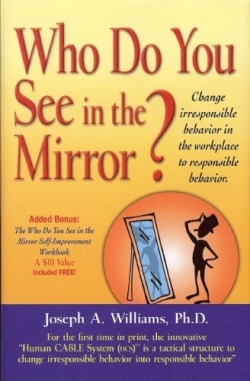
Who Do You See in the Mirror?
Change Irresponsible Behavior in the Workplace to Responsible Behavior
The metaphor of the mirror is used in psychology, books, and even the famous Michael Jackson song, to help people view their actions objectively. The central theme of Who Do You See in the Mirror? is the trend toward irresponsible behavior in the workplace and what can be done to reverse it. Joseph A. Williams, who holds a doctorate in Applied Management and Decision Science, makes the point that irresponsible behavior can be changed, from the lowest levels of an organization all the way up to corporate management, and he offers a simple system to help people achieve that.
Williams describes the system he developed to help employers and employees identify and understand work-related actions and inaction that may originate from their own unique behavioral backgrounds and take action to improve irresponsible behavior. “The Human CABLE System (HCS) behavioral makeover process is a strategy that, while practiced repeatedly on the individual level, has the potential to effect global behavioral change,” Williams writes.
The HCS is based on five elements of human behavior-Consequence, Attitude, Behavior, Learning, and Environment. The system is aligned with twelve common sense principles of responsible behavior. Simply put, if one is aware of the effects of attitude and environment on one’s behavior and learns from the consequences of that behavior, the system can help drive behavioral improvements.
Williams’ writing has personality, with a casual style reminiscent of the storytelling style of Ken Blanchard, author of The One Minute Manager. In the format of informal coffee shop chats, the main character, Joe, facilitates discussions with a diverse group of workers in which they discuss behavioral issues in the workplace. Joe is like a consultant, gathering input from the group, sharing knowledge, and encouraging them to “look in the mirror” to analyze their own behavior. The stories in the book were inspired by surveys, interviews, and discussions with actual workers. One story about a woman named Donna explores the connection between early childhood environment and behavior in the workplace. Donna’s management style of giving constructive feedback to her team and accepting accountability for her actions is a result of her prior success with those actions.
The book cites current examples of corporate irresponsibility by the likes of Enron, Bernie Madoff, and others. Behaviors exhibited by irresponsible employees, like tardiness, breaking rules, and blaming others for their own actions, are often triggered by upbringing, fear, greed, lack of trust, and lack of management enforcement of rules against disruptive behavior.
References to a workbook are a little misleading, as it’s not a separate pamphlet but is included as the last section of the book. This section contains a useful self-analysis behavior profile chart that readers can use to analyze their behavior and identify actions needed for change.
Williams’ corporate, academic, and union labor experiences bring a unique perspective to this book. He has thirty years of corporate experience working for two Fortune 500 companies and seven years of experience working as an hourly employee of a major airline.
Who Do You See in the Mirror? provides an introspective look at how behavior can be changed through awareness and action and an easy system for positive change in the workplace and beyond.
Disclosure: This article is not an endorsement, but a review. The publisher of this book provided free copies of the book and paid a small fee to have their book reviewed by a professional reviewer. Foreword Reviews and Clarion Reviews make no guarantee that the publisher will receive a positive review. Foreword Magazine, Inc. is disclosing this in accordance with the Federal Trade Commission’s 16 CFR, Part 255.
